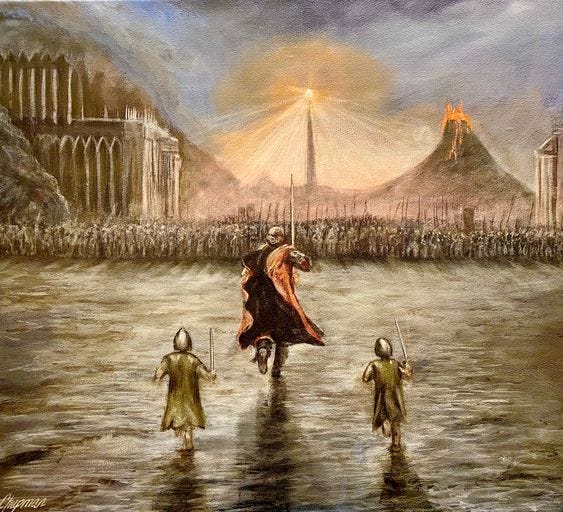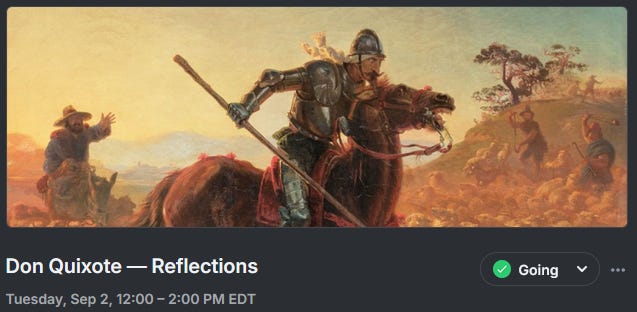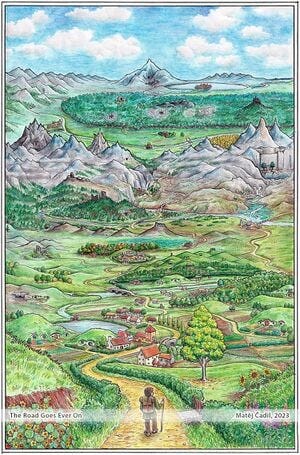Could You Be the Next Hero?
The Hero’s Journey as the path to your true self
The great books teach you how to become the hero of your own story.
That’s because all heroes, despite differences in background, culture, and setting, follow the same archetypal path.
This path isn’t just a literary device. It’s a blueprint for living a meaningful life — one that calls you toward your true destiny.
It’s called the Hero’s Journey: a universal pattern humanity has followed for millennia, not only to live adventurous lives, but to live moral ones — lives that restore order, create beauty, and affirm that life is good and worth living despite its trials.
Here’s the archetype of the Hero’s Journey, and why learning it can lead you to your life’s destiny…
Don’t forget to join our FREE book club!
We started a digital book club to study the great texts of Western Civilization — from Dante to Dostoevsky — together. Inside, you’ll get:
Live community book discussions (bi-weekly)
New, deep-dive literature essays every week
The entire archive of book reviews + our 100 great texts reading list
Our second discussion on Don Quixote will take place on September 2 at 12pm EST!
Sign up below to attend — all paid members can join the live discussion up on stage…
Note: paid subscribers via Substack will automatically receive an access link for the live calls.
Answering the Call
The Hero’s Journey was popularized by Joseph Campbell in his work The Hero with 1,000 Faces.
He asserts that at the heart of great literature and true heroism is a clear blueprint and structure. While there’s a few variations on the Hero’s journey, the most popular structure is shown below.
We’ll explain this journey using Bilbo from Tolkien’s The Hobbit.
So the Hero’s journey begins with the hero living in the ordinary world. In this case, Bilbo is in the Shire, living a tranquil life as a Hobbit.
He’s not strong, a warrior, nor heroic by any means, but that’s exactly the point — the hero’s journey is not about celebrating the specific few with divine talent, rather it calls all of mankind out of the ordinary.
This is why the first two steps are both the call to adventure, and a refusal.
In Bilbo’s case, Gandalf invites him on a journey across Middle Earth to steal treasure from a dragon, but Bilbo refuses:
“Who am I to steal from a dragon? I’m no hero, I’m just a Hobbit!”
Many are called, but few are chosen.
Nonetheless, after this refusal, the hero has a change of heart. Sometimes he’s called to accept the adventure by force (think Luke Skywalker, forced to leave his farm after the empire destroys it), but in Bilbo’s case, he feels a spirit/interior heroism calling him outward.
Bilbo accepts the call and leaves the Shire into the strange new lands of Middle Earth, which is the 3rd step, crossing the threshold.
It’s here where the journey really begins…
Becoming a Hero
Once the hero crosses the threshold, he enters a strange new world. He makes new allies, but faces new trials and tribulations.
Here the hero tends to struggle, but persevere.
In Bilbo’s case, he befriends nine dwarfs, but proves to be a liability in battle. He’s defenseless, fearful, and “dead weight.”
Nonetheless, Bilbo perseveres. He grows braver, facing off against orcs, spiders, giants, and even gollum. In due time, he becomes a formidable warrior and even saves his imprisoned companions.
But there’s a deeper reason for these trials and tribulations beside becoming virtuous. They become a preparation for the ultimate ordeal, the stage in which the hero enters the abyss.
It’s here where the hero faces the ultimate foe, that his entire quest hinges upon. Defeat means failure and death, but victory earns rewards beyond comprehension.
This is because the hero’s journey is not about the path to riches, nor a proverbial princess, nor a subjective path to meaning. The hero’s journey is about saving the world, and restoring order, virtue, and goodness where others see but chaos.
For Bilbo, this means taking on Smaug the Dragon head on…






